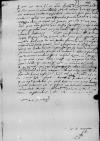List #1926
Ioannes DANTISCUS do Tiedemann GIESEHeilsberg (Lidzbark Warmiński), 1538-09-20
Regest polski:
Dantyszek niecierpliwie czeka na powrót krawca, prosi Giesego o interwencję w tej sprawie. Pyta, o jakiej porze dnia Giese przybędzie do Dobrego Miasta.
Nadeszły listy z dworu królewskiego. Dantyszek dziwi się, że w przesyłce pośredniczył książę Albrecht [I Hohenzollern-Ansbach]. Sługa, którego Dantyszek posłał do Krakowa [Filip Szczepanowski], zatrzymał się tam z powodu śmierci swego ojca [Erazma Szczepanowskiego]. Drugi posłaniec [Mauritius] powinien wkrótce powrócić.
Dantyszek przesyła Giesemu list otrzymany od [Samuela] Maciejowskiego oraz list [od Georga Hegla?], dotyczący postępowania sługi Fuggerów [Vincentza Walcha], a także skierowany do Giesego list królowej [Bony Sforzy]. Wkrótce spodziewa się listu króla [Zygmunta I] w sprawach publicznych.
| odebrano 1538-09-21 Rękopiśmienne podstawy źródłowe:
Publikacje:
| ||||||
Tekst + aparat krytyczny + komentarzZwykły tekstTekst + komentarzTekst + aparat krytyczny
Reverendissimo Domino
Reverendissime mi Domine, frater et amice carissime et honorande.
Salutem et fraterni amoris commendationem.
Hunc
Misit mihi pauloante
illustrissimus dominus
Quae mihi scripsit dominus decanus Cracoviensis
Interim Dominatio Vestra Reverendissima, cuius adventum magna cum alacritate desidero, felicissime valeat.
Ex
Reverendissimae Dominationis Vestrae frater integerrimus
[1 ]
The recent stay of Dantiscus in
[2 ] Probably the cf.

